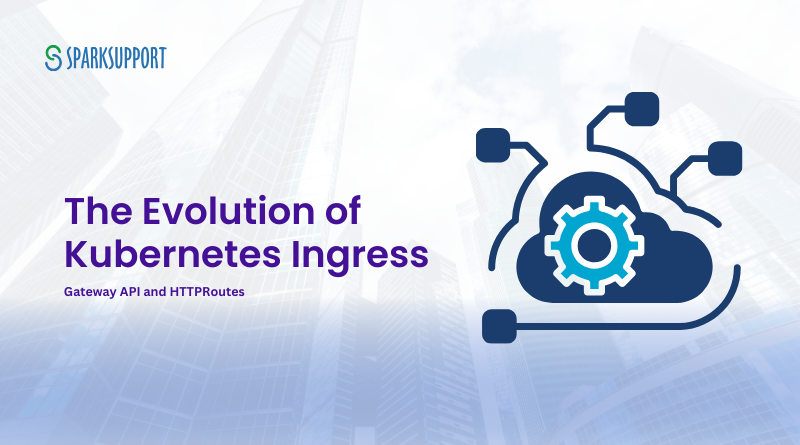Kubernetes has always been at the forefront of innovation in managing and scaling cloud-native applications. One of the key components of Kubernetes networking is ingress management, traditionally handled through ingress controllers. However, as applications scale and the need for flexibility grows, the limitations of the traditional ingress model have become apparent.
Enter Gateway API and HTTPRoutes – a more modular, powerful, and future-proof approach to managing ingress traffic. If you’re looking to modernize your Kubernetes networking and optimize scalability, it’s time to explore this new approach. And if you need expert guidance, hire Kubernetes experts from Sparksupport’s offshore IT services to ensure seamless implementation.
The Traditional Way: Ingress and Ingress Controllers
The traditional Kubernetes ingress resource provides a way to manage external access to services within the cluster. Paired with an ingress controller (e.g., NGINX, Traefik, or Istio ingress gateway), it allows you to define routing rules for HTTP/S traffic.
While ingress is widely adopted, it has several limitations:
- Tight Coupling: Ingress resources are tightly coupled with specific ingress controllers, making it difficult to switch between controllers without significant reconfiguration.
- Limited Features: The ingress resource provides a one-size-fits-all approach, lacking advanced features such as granular traffic splitting or precise policy management.
- Scalability Challenges: As clusters grow and traffic patterns become more complex, the ingress resource often falls short in providing the necessary flexibility and scalability.
The New Way: Gateway API and HTTPRoutes
The Gateway API introduces a more flexible and extensible way to manage ingress traffic. It decouples the routing configuration from the underlying ingress controller, providing a standardized API that works across multiple implementations.
Key Features of Gateway API:
- Modularity: Separate resources for gateways (the entry point for traffic) and routing (HTTPRoutes, TCPRoutes, etc.).
- Controller Agnostic: Allows you to switch between ingress controllers seamlessly by changing the GatewayClass without modifying your routing configuration.
- Granular Control: Supports advanced use cases like traffic splitting, header-based routing, and fine-grained policies.
- Namespace Isolation: Enables teams to define their own HTTPRoutes in their namespaces while using a shared Gateway.
- Future-Proof: Designed with extensibility in mind to accommodate emerging protocols and traffic patterns.
Why Gateway API is a Replacement for Traditional Ingress
- Decoupling: Unlike the traditional ingress model, the Gateway API separates the data plane (gateway) from the control plane (HTTPRoutes). This separation allows you to manage and update routing rules independently of the underlying gateway implementation.
- Controller Interchangeability: Switching between ingress controllers no longer requires reconfiguring your entire ingress setup. Simply create a new Gateway resource pointing to a different GatewayClass.
- Scalability: Gateway API’s modularity and extensibility make it ideal for managing complex traffic scenarios in large-scale deployments.
Example: Using Gateway API and HTTPRoutes
Let’s compare the traditional ingress approach with the Gateway API using a simple example: routing traffic to a hello-world application.
Traditional Ingress Example:
| apiVersion: networking.k8s.io/v1 kind: Ingress metadata: name: hello-world-ingress spec: rules: – host: hello.example.com http: paths: – path: / pathType: Prefix backend: service: name: hello-world port: number: 80 |
Here, the ingress resource is directly tied to a specific ingress controller, such as NGINX. If you want to switch to another controller, you’ll need to rewrite the configuration to suit the new controller’s specifics.
Gateway API Example:
- Define a Gateway:
| apiVersion: gateway.networking.k8s.io/v1beta1 kind: Gateway metadata: name: hello-gateway spec: gatewayClassName: istio # Or any other controller, e.g., nginx, haproxy listeners: – name: http protocol: HTTP port: 80 |
- Define an HTTPRoute:
| apiVersion: gateway.networking.k8s.io/v1beta1 kind: HTTPRoute metadata: name: hello-world-route spec: parentRefs: – name: hello-gateway rules: – matches: – path: type: Prefix value: / backendRefs: – name: hello-world port: 80 |
In this setup:
- The Gateway resource defines the entry point for traffic.
- The HTTPRoute resource specifies how traffic is routed to the backend service.
Switching to a new ingress controller is as simple as creating a new GatewayClass and updating the gatewayClassName field in the Gateway resource.
Benefits of the New Approach
- Flexibility: Teams can manage their own HTTPRoutes without worrying about the underlying gateway configuration.
- Ease of Migration: Transitioning from one ingress controller to another is seamless.
- Scalability: Supports advanced traffic management features required in modern applications.
- Improved Observability: Gateway API provides detailed observability features for monitoring traffic flows.
- Future-Ready: Supports emerging use cases like ambient mesh and protocol-specific routing.
Conclusion
The Gateway API and HTTPRoutes represent a significant step forward in Kubernetes networking. By decoupling routing configuration from the underlying ingress controller, they provide the flexibility, scalability, and ease of use required for modern cloud-native applications. Whether you’re managing a small cluster or a large-scale deployment, adopting the Gateway API is a move towards a more future-proof and manageable ingress solution.
Please start exploring Gateway API today and experience the power of modular and controller-agnostic ingress management in Kubernetes!



